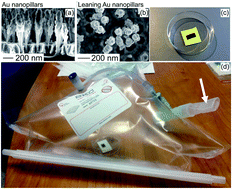SERS spectroscopy for detection of hydrogen cyanide in breath from children colonised with P. aeruginosa
Abstract
There is a need for a fast and non-invasive tool to detect Pseudomonas aeruginosa airway colonisation in cystic fibrosis (CF) patients unable to expectorate. Fifty CF children and 19 controls aged 5–17 years were included in the feasibility study. A surface-enhanced Raman spectroscopy (SERS) nanochip optimised for detection of trace amounts of the P. aeruginosa biomarker hydrogen cyanide (HCN) was mounted inside a Tedlar bag, which the patient breathed into. The SERS chip was then analysed in a Raman spectrometer, investigating the C![[triple bond, length as m-dash]](https://www.rsc.org/images/entities/char_e002.gif) N peak at 2131 cm−1 and correlated with sputum cultures. One new P. aeruginosa colonisation occurred during the trial period. The C
N peak at 2131 cm−1 and correlated with sputum cultures. One new P. aeruginosa colonisation occurred during the trial period. The C![[triple bond, length as m-dash]](https://www.rsc.org/images/entities/char_e002.gif) N peak intensity was enhanced in this sample in contrast to the subject's 3 other samples. Three additional patients had intense C
N peak intensity was enhanced in this sample in contrast to the subject's 3 other samples. Three additional patients had intense C![[triple bond, length as m-dash]](https://www.rsc.org/images/entities/char_e002.gif) N SERS signals from their breath, but no P. aeruginosa was cultured from their sputum. It is concluded that SERS spectroscopy can be developed into an easy to use hypersensitive clinical prescreening method for detection of HCN in human breath.
N SERS signals from their breath, but no P. aeruginosa was cultured from their sputum. It is concluded that SERS spectroscopy can be developed into an easy to use hypersensitive clinical prescreening method for detection of HCN in human breath.



 Please wait while we load your content...
Please wait while we load your content...